Cost $35 million Launched 15 May 1972 Beam 25 m | Yard number 39 Length 191 m Builder Swan Hunter | |
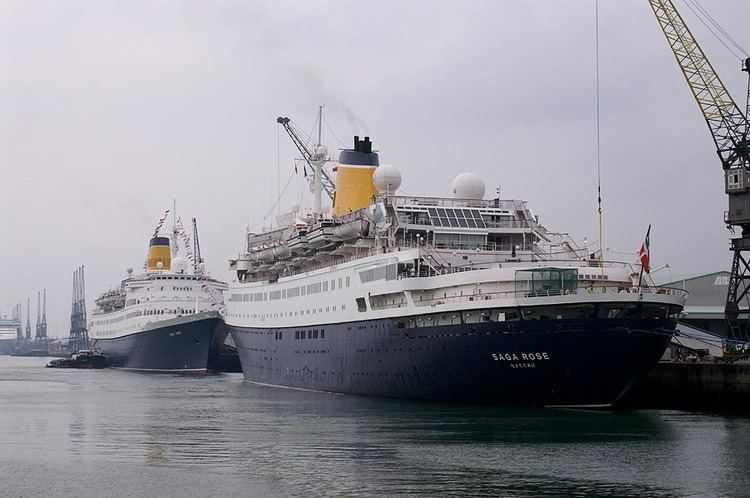 | ||
Name 1973–1999 Vistafjord
1999–2004 Caronia
2004-2014 Saga Ruby
from 2014 Oasia Owner 1973–1983 Norwegian America Line
1983–1998 Cunard Line
1998-2004 Carnival Corporation & plc
2004-2014 Acromas Shipping Ltd
from 2014-2017 Millenium View Ltd, Singapore
from 2017-present Alang Operator 1973–1983 Norwegian American Line
1983–2004 Cunard Line
2004-2014 Saga Cruises Port of registry 1973–1983 Oslo, Norway
1983–1999 Nassau, Bahamas
1999–2004 Southampton, United Kingdom
2004–2010 London, United Kingdom
2010–2014 Valletta, Malta
from 2014 Nassau, Bahamas | ||
Ms saga ruby a photo history
MS Saga Ruby is a cruise ship that was owned and operated by Saga Cruises. She was built as the combined ocean liner/cruise ship Vistafjord in 1973 by Swan Hunter Shipbuilders in the United Kingdom for the Norwegian America Line. In 1983 she was sold to Cunard Line, retaining her original name until 1999 when she was renamed Caronia. In 2004 she was sold to Saga and sailed as Saga Ruby until sold in 2014 for use as a floating hotel and renamed Oasia.
Contents
- Ms saga ruby a photo history
- Concept and construction
- Norwegian America Line
- Cunard Line
- Saga Cruises
- Farewell Voyage with Saga
- Floating Hotel Oasia
- Exterior design
- Technical details
- Generators
- Air conditioning
- Auxiliary
- Boilers
- Refrigeration
- Stabilisers
- Water production plant
- Steering gear
- References
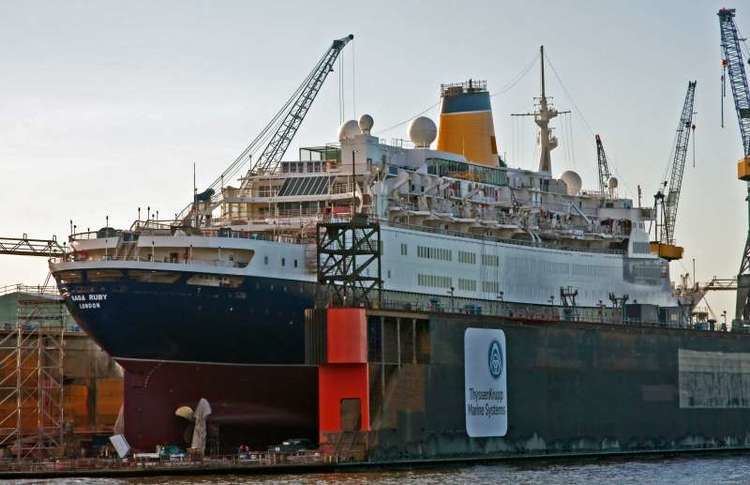
Concept and construction
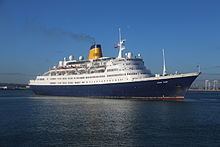
The Vistafjord was ordered by Norwegian America Line (NAL) from Swan Hunter Shipbuilders, Newcastle, United Kingdom. She was based on the company's 1965-built MS Sagafjord, but with an enlarged hull, additional superstructure deck and improved interior layout. However, as the cost of building the Sagafjord had put her builders, Forges et Chantiers de la Mediterranee, out of business, the Vistafjord had to be built at a different shipyard. She was launched on 15 May 1972 and delivered to the Norwegian America Line exactly a year later on 15 May 1973. She is the last cruise ship to have been built in the United Kingdom.
Norwegian America Line
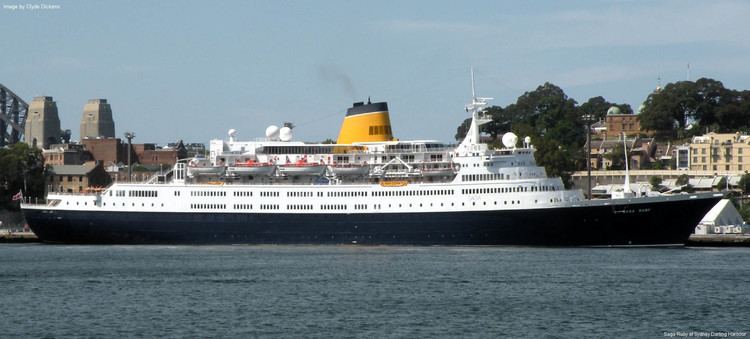
On 22 May 1973 the Vistafjord set on her maiden voyage, a transatlantic crossing from Oslo to New York. At the time the Norwegian-flagged Vistafjord was considered to be amongst the most luxurious cruise ships in the world, sharing the top 5 in Berlitz Complete Guide to Cruising with the Sagafjord and Royal Viking Line's Royal Viking Star, Royal Viking Sky and Royal Viking Sea for several years. In early 1980, the vessel was famously chartered by car manufacturer British Leyland to internally launch the Austin Metro to its British dealer network.
Although their ships were high-rated, Norwegian America Line had trouble making profit.
Cunard Line
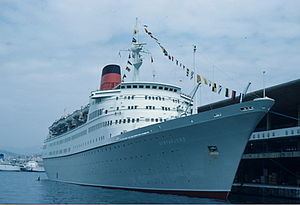
In 1983 Trafalgar House, the owners of Cunard Line, purchased NAL and in October 1983 the Vistafjord joined the Cunard fleet where she, together with her sister ship Sagafjord, remained as one of the world's top cruise ships. She retained her original name and the grey NAL hull colour, but received Cunard Line funnel colours and was re-registered to the Bahamas. Despite the flag change she retained Norwegian command staff.
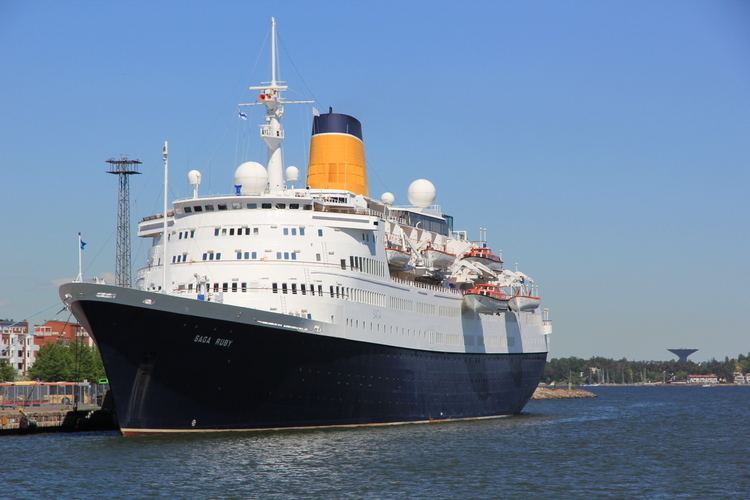
In 1999 the decision was made to rename the Vistafjord with a more traditional Cunard Line name. On 10 December 1999 she was renamed Caronia and re-registered in the United Kingdom.
Saga Cruises
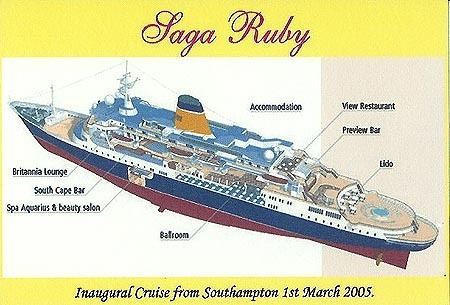
She continued service with Cunard until November 2004, when she was sold to Saga Cruises. Following a £17 million refit at Valletta, Malta the Caronia reappeared as Saga Ruby in March 2005. In the Saga Cruises fleet she joined her former Norwegian America Line fleetmate Sagafjord (now named Saga Rose).
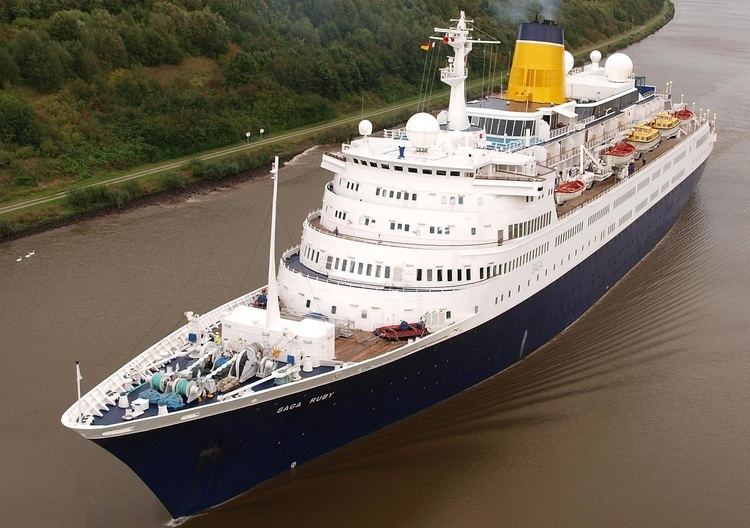
It was reported in 2012 that Saga Cruises would retire the Saga Ruby in 2014 and the Quest for Adventure would move back into the fleet as the Saga Pearl II.
Farewell Voyage with Saga
She sailed her final world cruise in the first months of 2013. However it was marred by technical difficulties which kept the ship in Southampton until late February, which led to the cruise being renamed the 'Grand Voyage' visiting South America and South Africa.
It was reported that the Saga Ruby would depart on her final cruise with Saga Cruises on 7 December 2013 roundtrip from Southampton, England on a 31-day voyage to the Caribbean stopping at ports Praia da Vitória, Azores; Bridgetown, Barbados; Port of Spain, Trinidad and Tobago; Kingstown, St Vincent; St George's, Grenada; Castries, St Lucia; Roseau, Dominica; Basseterre, St Kitts; St John's, Antigua; Funchal, Madeira; Lisbon, Portugal; La Coruña, Spain (for Santiago de Compostela). While on her final cruise she was forced to change her itinerary to a Western Mediterranean cruise stopping at Tenerife; Almeria, Spain; Valletta, Malta; Messina, Sicily; Naples, Italy; Civitavecchia (for Rome); Livorno (for Florence, Pisa); Monte Carlo; Barcelona, Spain; Valencia, Spain; Gibraltar; Funchal, Madeira; Lisbon, Portugal; La Coruna; and finally returning to Southampton on January 7, 2014. While in Funchal, Madeira the Saga Ruby met up with the Saga Sapphire for a New Year's Eve fireworks display; due to problems with one generator after reaching the Canary Islands. The loss of that generator meant that there was insufficient power available to run the air conditioning plant. The cruise also returned to Southampton late due to poor weather in the Bay of Biscay, eventually arriving on 9 January 2014, with passengers disembarking on 10 January.
Floating Hotel Oasia
In January 2014 she was sold for $14M USD to Millennium View Ltd, a privately held company based in Singapore. The new owners plan to convert her into a floating hotel in Burma. In mid-February 2014 she sailed from Gibraltar as Oasia under Bahamas flag and management of FleetPro Ocean. With much sadness, in February 2017, it was announced that Oasia was being sold for scrap. This came as quite a surprise to many, as the ship, still SOLAS compliant, had recently undergone a $10 million USD overhaul as a hotel and museum ship. She was found in Thailand, awaiting tow to scrapping, after having 20 million USD invested in her.
Exterior design
The Vistafjord was built with a very traditional ocean liner profile, with the funnel placed amidship and a notable sheer on her hull. The superstructure is terraced both at the fore and aft of the ship. In two refits during her Cunard Line career additional structures were added to the rear and top of the superstructure.
In Norwegian America Line service the Vistafjord carried the traditional NAL livery, with a grey hull, white superstructure, yellow mast and a yellow funnel with red, white and blue (colours of the flag of Norway) stripes. Following sale to Cunard she retained the grey hull colour, but her funnel was painted in the red/black Cunard colours and her mast white. A red "Cunard" text was later added to her superstructure. Coinciding with her renaming into Caronia in 1999 the ship's hull was repainted black. As Saga Ruby her hull was repainted dark blue and her funnel yellow, with a dark blue top and a narrow white stripe separating the two colours.
Technical details
Generators
- Starboard Outer is #1, engine serial number #1986.
- Starboard Center is #2, engine serial number #1987.
- Starboard Inner is #3, engine serial number #1988.
- Port Inner is #4, engine serial number #1989.
- Port Centre is #5, engine serial number #1990.
- Port Outer is #6, engine serial number #1991.
Air conditioning
Three Carrier 19XL5353306CR (R134a) marine air conditioning units which supplies treated chilled fresh water to 42 air handling units (AHU). The Carrier units each consume 400 kW (at 100%) of electricity for the motors, which results in 1,734 kW (5,917,000 Btu/h) cooling from the plant. The AHU’s provide 14,750,000 cu ft/h (418,000 m3/h) of conditioned air. This relates to 8 air changes per hour in cabins, 15 changes per hour in the public rooms, and 60 changes per hour in the galley.
Auxiliary
Boilers
- 2 Spanner oil–fired Swirlyflow boilers type j.5655/6 producing 11,000 kg/h (24,300 lb/h) using an average of 3 tonnes per day of fuel.
- 2 main engine Spanner Swirlyflow exhaust gas boilers type J.5657/58 producing 6,200 kg/h (13,700 lb/h).
Refrigeration
Stabilisers
Denny Brown AEG units which have a designation “Swan Hunter Ship 39 Contract”. They take a full load current of 26 kW per main motor, and have a fin length of 15 feet (4.6 m), and are 7 feet (2.1 m) wide.
Water production plant
Three water production plants on board capable of producing 627 tonnes per day. They are the following:
- An Atlas-Danmark Distiller AFGU 2SN091 which is a 200 tonne per day unit.
- A Matrix Reverse Osmosis 66K SWRO Silver-D which is a 250 tonne per day unit.
- A Matrix Reverse Osmosis 44K SWRO Silver D produces 120 tonnes per day.
Steering gear
- The Steering Gear was manufactured by AEG is a vane type RDC 630/100 with a Standard Vickers VSG Mark III Pump. It also has an unusual emergency steering pump, which is driven by a pneumatic motor.
